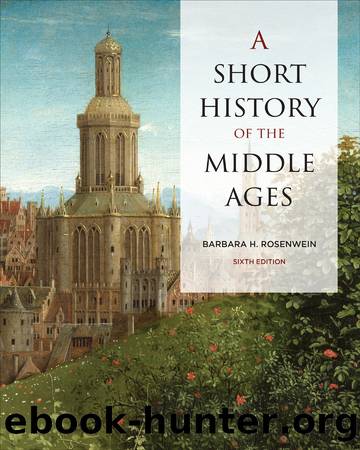A Short History of the Middle Ages, Sixth Edition by Rosenwein Barbara;

Author:Rosenwein, Barbara;
Language: eng
Format: epub
Tags: Middle Ages – Europe – History – 476–1492
Publisher: University of Toronto Press
Christian Spain and Portugal
While England was conquered in a day, the reconquista took centuries. (Then, again, Iberia is four and a half times as large as England!) It was a very lucrative enterprise, initially made possible by the disintegration of al-Andalus into weak and competitive taifas. The fledgling Christian states in the north â León, Castile, Navarre, and Aragon â staged plundering raids, confiscated lands and cities, and (until the Almoravids put an end to it) collected tribute in gold from taifa rulers anxious to stave off attacks.
Nor were the northern states the only beneficiaries of these wars. When Rodrigo DÃaz de Vivar, the Cid (from the Arabic sidi, lord), fell out of favor with his lord, Alfonso VI, king of Castile and León, he and a band of followers found employment with al-Mutamin, ruler of Zaragoza. There he defended the city against Christian and Muslim invaders alike. In 1090, he struck out on his own, conquering Valencia in 1094 and ruling there until his death in 1099. He was a Spaniard, but other opportunistic warriors sometimes came from elsewhere. In fact, Pope Alexander IIâs call to besiege Barbastro in 1064 appealed to knights from France.
Spainâs French connections were symptomatic of a wider process: the Europeanization of Christian Spain. Initially the northern kingdoms were isolated islands of Visigothic culture. But already in the tenth century, pilgrims from France, England, Germany, and Italy clogged the roads to the shrine of Saint James (Santiago de Compostela; see Map 5.7), while in the eleventh century, monks from the French monastery of Cluny arrived to colonize Spanish cloisters. At the same time, Alfonso VI actively reached out beyond the Pyrenees. He cultivated ties with Cluny, doubling the annual gift of 1,000 gold pieces that his father, Fernando I, had given to the monks there in exchange for prayers for his soul. He also sought recognition from Pope Gregory VII as âking of Spain,â and in return he imposed the Roman liturgy throughout his kingdom, stamping out traditional Visigothic music and texts.
In 1085 Alfonso made good his claim to be more than the king of Castile and León by conquering Toledo. This was the original reason why the Almoravids came to Spain, as we saw on p. 170. After Alfonsoâs death, his daughter, Queen Urraca (r.1109â1126), ruled in her own right a realm larger than England. Her strength came from the usual sources: control over land, which, though granted out to counts and others, was at least in theory revocable; Church appointments; a court of great men to offer advice and give their consent; and an army to which all men â even arms-bearing slaves â were liable to be called up once a year.
In the wake of Almoravid victories, however, two new Christian states, Aragon-Catalonia and Portugal, began to challenge the supremacy of Castile and León. Aragon had always been a separate entity, but Portugal was the creation of Alfonso VI himself. As king of León, he ruled over the county of Portugal (the
Download
This site does not store any files on its server. We only index and link to content provided by other sites. Please contact the content providers to delete copyright contents if any and email us, we'll remove relevant links or contents immediately.
| Great Britain | General |
| Bath | Devon |
| Gloucestershire | London |
| Yorkshire |
Room 212 by Kate Stewart(4113)
The Crown by Robert Lacey(4113)
Endurance: Shackleton's Incredible Voyage by Alfred Lansing(3854)
The Iron Duke by The Iron Duke(3650)
The Rape of Nanking by Iris Chang(3526)
Killing England by Bill O'Reilly(3461)
Joan of Arc by Mary Gordon(3269)
Say Nothing by Patrick Radden Keefe(3069)
I'll Give You the Sun by Jandy Nelson(2846)
Hitler's Monsters by Eric Kurlander(2737)
Shadow of Night by Deborah Harkness(2729)
Margaret Thatcher: The Autobiography by Thatcher Margaret(2688)
Mary, Queen of Scots, and the Murder of Lord Darnley by Alison Weir(2681)
Darkest Hour by Anthony McCarten(2650)
Blood and Sand by Alex Von Tunzelmann(2611)
Red Famine: Stalin's War on Ukraine by Anne Applebaum(2470)
Eleanor & Park by Rainbow Rowell(2399)
The One Memory of Flora Banks by Emily Barr(2350)
Book of Life by Deborah Harkness(2272)
